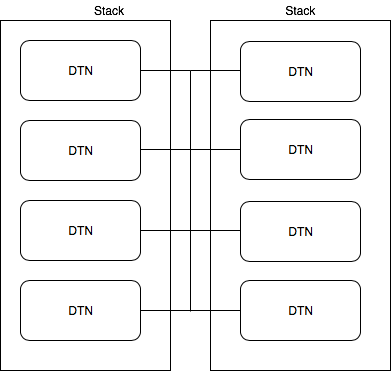 Large Data Flow Appliance
Large Data Flow Appliance
Documentation
Go to Horizon to
launch at CHI@UC
Go to Horizon to
launch at CHI@TACC
Description
It is important to provide researchers with support for experiments requiring large data flows, including high-performance data movement in experimental cloud environments. This support involves tuning many different components to achieve a high-performance system. Often, it is the case that learning, setting up, and tuning the system and tools takes the majority of the time for experimenters. Providing a pre-tuned environment, tools for experiments, and reference performance results for researchers would assist them to be more productive. This Appliance helps users to build a set of compute nodes to test a large data flow network application between multiple DTNs.
For how to use this appliance, please refer to the documentation.
Design

Each stack of the appliance consists of multiple DTNs connected in a user-defined network. Each DTN is fine-tuned for large data flow application, fully utilizing the available network capacity. It comes with multiple tools to test the network and disk performance of the DTN. Users can test each DTN within an appliance or spawn multiple stacks of the appliance to test between them.
Requirement
For each stack of the appliance, minimum of 5 bare-metal compute node need to be available in an active reservation.
Also, the user needs to specify the network that the DTNs will be connected to.
What's available?
Each DTN comes with an Ubuntu 16.04 node with network stack optimization for 10 Gbps. It comes with network testing tool such as iperf, iperf3 and nuttcp and disk testing tool, fio.
In addition to the tools, Chameleon Large Flow Tester is included to test between each DTN. It automates network test and disk test end to end and allow users to emulate arbitrary network environments, such as delay, jitter, and loss rate.
Heat Template
Heat Template requires few inputs from the user at the time of stack creation.
Key pair for the Chameleon Cloud.
Reservation ID with at least 5 available bare-metal nodes.
Network ID for attaching the DTNs to.
After the stack is spawned, it outputs
Internal IP address of each DTN in the specified network.
Internal IP address of the Head node (Access node to other DTN) in the specified network.
Floating IP address of the Head node the user can ssh into.
Keywords
networkingTemplate
Author
| Name: | Se-young Yu |
| Contact: | young.yu@northwestern.edu |
Support
| Name: | Se-young Yu |
| Contact: | young.yu@northwestern.edu |
| Version: | 1.0 |
| Created By: | youf3 on May 3, 2018, 2:50 p.m. |
| Updated By: | youf3 on Feb. 7, 2019, 9:24 a.m. |